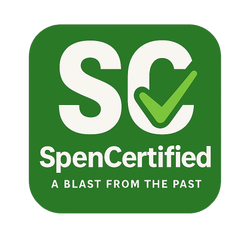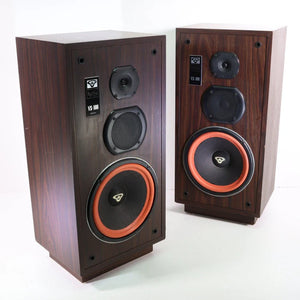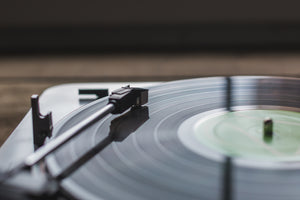We are unable to reply to comments, so please message us directly if you have a specific question regarding products, shipping costs, etc. Our office number is (480) 207-1511. Our email is hello@spencertified.com. You can also message us on Facebook. Commonly asked questions and answers can be found on our FAQs page here.

TURNTABLE JARGON | TERMS TO BECOME FAMILIAR WITH BEFORE YOU INVEST IN A TURNTABLE
IMPORTANT WORDS, TERMS, AND FEATURES THAT YOU NEED TO KNOW BEFORE BUYING A TURNTABLE
The turntable’s humble roots go way back to 1857 when the phonautograph was invented by Edouard-Leon Scott de Martinville. The phonautograph paved the way for the phonograph from Thomas Edison in 1877, then the graphophone from Alexander Graham Bell, then finally the gramophone from Emile Berliner in 1887. This gramophone became the basis of the contemporary record player, which hit its golden age in the 60s and 70s.
And they’re here to stay - despite the invention of other ways to listen to music, the sales of turntables and records keep spinning and spinning (pun intended). And if you’re looking to invest in one of these systems - awesome! But before you do, there are a few important terms you need to become familiar with.
TURNTABLE VS RECORD PLAYER
Turntable - A turntable will just spin the record, but it won’t have speakers or an amp. A turntable is just one individual component that is part of a record player.
Record Player - A record player is the turntable along with the speakers and the amp.
Pro tip: Want to grind the gears of an audiophile? Call a turntable a 'record player.' If you want to get them really good, call a turntable a 'vinyl player!'
DEFINITIONS
Needle - The needle, AKA the stylus, is the part of the record player that comes into direct contact with the upward-facing side of the album as it spins.
Cartridge - The cartridge is the part mounted on the end of the tonearm of your record player.
Headshell - Many turntables use a headshell to mount the cartridge.
Tonearm - The tonearm is the part that assists in stabilizing the needle on the record. It also controls the placement of the needle.
Direct Drive - Direct drive means the turntable is gear-driven and does not have belts.
Belt Drive - Belt drive means that the turntable spins using a belt.
Linear Tracking - Linear tracking means that the needle tracks in a straight line. These systems are often more effective for getting the needle in the center of the groove.
![]()
Weight - The weight is used for adjusting the needle's tracking force.
Phono - This is the type of connection that most turntables will require to operate. It is usually accompanied by a ground screw. If you don’t ground it, you will often get bad buzzing or hissing. Plus, if you connect this to a line connection instead of a phono connection, it will sound terrible.
Ground - The ground is used for setting the turntable and the amplifier at the same ground potential. Some turntables don’t have a ground wire.
Line - Some turntables have a switch for setting the turntable to line or phono. On the line setting, you can use a line connection. Any red and white analog connection will work. You just can’t connect it to a phono connection.
Phono Preamp - A phono preamp will convert the audio from phono to line.
Turntable with Preamp - In order to get proper record playback, a preamp is required somewhere in your audio system. Some turntables have a built-in preamp, allowing you to directly connect your turntable to a receiver or amplifier with plugged in speakers. If your turntable doesn’t have one, you will need an amplifier with a built-in preamp or to get an external / stand-alone preamp.
Bluetooth Turntable - Some modern turntables have built-in Bluetooth. This allows you to integrate it with any Bluetooth speaker system or wireless headphones. They also have traditional RCA outputs so you can connect it to wired speakers.
Pitch Control - Pitch control will adjust the playback speed. Most turntables that have this feature are adjustable up to + or - 5%.
Strobe Light - This is used for setting the correct pitch.
Speed - Records can have up to four different speeds: 16, 33, 45, and 78. The speed is measured in RPMs or Revolutions Per Minute; AKA, the rotations per minute.
A 4-speed turntable plays all record speeds. A 3-speed does three of the speeds, typically 33, 45, and 78. A 2-speed does 33s and 45s, and a 1-speed does 33s.

45 Adapter - the 45 adapter allows for 7-inch (17cm) records that have the larger center to fit your turntable. There are single-play and multiplayer adapters. Multiplayer adapters are usually specific to certain turntables.
Anti-Skate - An anti-skate will help keep the record in its groove. When a record glides across the record, that is called skating. Turning up the anti-skate adjustment will keep it more in the groove, and setting it to zero will turn off the anti-skate.
Size - Size refers to the actual size of the record. There are 7-, 10-, and 12-inch records.
Auto-Repeat - Auto-repeat will automatically repeat the record. Some turntables will continue to repeat nonstop and others will allow you to pick how many times it repeats.
Cue - The cue will elevate and lower the needle. This is useful when placing and removing the needle from the record.
TYPES OF TURNTABLES
Manual - A turntable that does not have any automatic functions. Requires the user to manually set down the tonearm at the start of a record and to manually return the tonearm to its rest when it’s finished playing.
Semi-Automatic - A turntable that is equipped with the ability to automatically return the tonearm to its rest after it finishes playing a record. Requires the user to manually set down the tonearm at the start of the record.
Automatic - A turntable equipped with both the ability to automatically set the tonearm into the appropriate start position to play a record and the ability to automatically return the tonearm to its rest after it finishes playing a record. Requires the least amount of user input.

Changer - An automatic turntable that can play more than one record and is equipped with a longer spindle to hold multiple records, typically between 6 to 8 records. Some may even hold as many as 14 records!
TYPES OF CARTRIDGES
Moving Magnet - A type of cartridge that uses a small permanent magnet on the stylus assembly, which produces audio signals when the stylus moves between two coils. This is the most common type of cartridge available.
Moving Iron - A type of cartridge that uses a hollow, temporary iron magnet as opposed to a permanent magnet on the stylus assembly. Grado and Goldring are known manufacturers of moving iron cartridges. Pickering and their DJ-oriented Stanton division also made moving iron cartridges.
Moving Coil - A type of cartridge that is the inverse of a moving magnet cartridge. The coil is attached to the stylus as opposed to a small magnet.
Crystal / X-tal - A type of cartridge that uses a rochelle salt crystal element which, when attached to a rubber yoke, produces audio signals when in contact with the stylus. This type is notorious for losing audio output as it degrades over time and was common in entry-level turntables until the late 1970s.
Ceramic - A type of cartridge that uses a ceramic element and functions the same way as a crystal cartridge but does not degrade over time.
FUNCTIONS
Auto / Reject - This button or lever will cycle a turntable, thus playing the next record on a record changer, repeating the same record on some automatic turntables, or returning the tonearm to its rest and shutting off the turntable on most automatic and semi-automatic turntables.
Auto Return - When the stylus reaches the runout groove of a record, it lifts the tonearm and returns it to its resting position, which shuts down the turntable. On a record changer, if there is at least one record remaining in a stack, it will play the next record.
Track Selection - Common in linear tracking turntables and turntables equipped with an optical sensor, this allows you to select a track on a record.
THE TECHNICAL
Runoff Groove - The end of a record’s grooves, after the last song, is called the runoff groove. On automatic and semi-automatic turntables, this will trigger the auto-return function.
Record - A record is a disc made out of a material called polyvinyl chloride. Depending on the size of the disc and speed it’s mastered for, it may contain between a single track per side to multiple tracks per side.

Vinyl - Another common term for records, as vinyl is the material used to press a record.
Vinyls - Many people will call multiple records “vinyls.” Technically, the plural of vinyl is vinyl. So don't call them vinyls!
Vinyl Player - While technically correct, the appropriate term is “turntable” or “record player,” depending on whether it has a built-in amplifier and speakers or not.
Dust Cover - This covers the turntable to protect it. Some turntables don’t have a cover.

SUMMARY
With the invention of CDs, digital downloads, and iPhones, the turntable is thought of by many as an obsolete system. Yet they’re making a comeback, and sales of vinyl records are soaring. Audiophiles and casual music lovers alike appreciate the uncompressed audio and nostalgia that turntables bring.
What’s the best record player system you can get? That depends on the features and audio setup you’re looking for. That’s why before investing in a turntable, it’s important to know the types of systems, cartridges, and features that are out there. So we hope that this guide helps with the basics and that you learned something new about turntables by reading this!
And if you’ve decided you want to buy a turntable, or you simply want to check out the types of vintage turntables that are out there, don’t hesitate to check out our large selection at this link. Thanks for reading our turntable guide. Have a great day!



Leave a comment